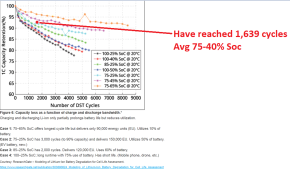zcskywire2
Solar Enthusiast
In most solar installs, the batteries are rarely fully cycled in a day (Either real cycles or equivalent cycles). Furthermore, it is rare to charge or discharge at a full 1C. (I try to design a system to be charged at around .3C or less and never above .5C). Charging and discharging slower tends to wear the battery slower so you get more cycles or equivalent cycles out of it.
To add to this, center charging/discharging lifepso4 batteries, just as you would with solar will make them last longer. We center tested some cells at work. They were cycled at ~25-75 soc. They just refused to die, we got >12k cycles at a way more aggressive profile than most people would use. We ended the testing before the cells failed. The full up and down cells crapped out months earlier.
Id also be curious if you had any other information on the lifecycle testing of that Ganfeng cell that you could share.




